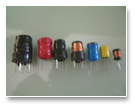
Inductors are passive electronic components that store energy in a magnetic field when electric current flows through them. Their behavior is defined by their inductance, measured in Henries (H). Different inductor types are optimized for various applications based on factors like frequency response, size, power handling, and cost. This guide details the common types: